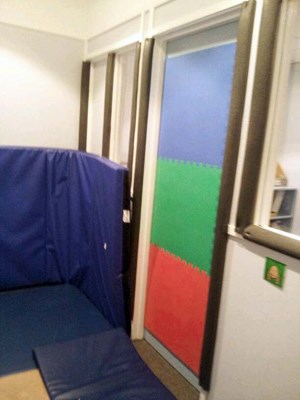Longtime school district critic Wendy Harris says the district shouldn't be placing special needs students in "safe rooms," and she fears that recent cuts to support staff in local schools will mean the spaces will be used more often as a way to manage distressed children.
Harris, whose son has special needs, hasn't had first-hand experience with the isolation rooms, but through her work on the district's parent advisory council, she's heard from parents whose children have been placed in the small rooms during outbursts.
One family in particular has expressed concerns about their son - a New Westminster Secondary School student - being placed in the isolation room for lengthy stretches and has been trying to have their situation resolved for three years, Harris said.
"The one at NWSS looks like it's about a five-by-five (room)," Harris said.
The district recently laid off 27 support staff members for the coming school year, and Harris worries the cuts will mean more special needs students will be without support and, as a result, will be relegated to the safe rooms more frequently.
"If this is the method because there is not enough staff and support, if this is the measure to control these kids, then what are we looking at? We are looking at an isolation room. We are looking at going back to the '50s," she said. "The concern is with these cutbacks, are more of these rooms going to be built? Is this how we are going to
manage these children?" Harris admits there are some students - those with sensory issues - who enjoy having a quiet space to retreat to. In those cases, she is fine with safe rooms.
"There are kids that are able to articulate, and
you know that they are getting overwhelmed. They just need a spot just to get away and quiet down," said Harris. "It's a space when they go of their own choosing - that's when they work. The problem is when kids who are having a meltdown are put in."
A 2009 Vancouver Sun story cited the experience of Natasha Mountain, whose son was being placed in a former custodian "closet,"
sometimes for as long as one hour, at a school in New Westminster.
Mountain withdrew her son from the school, the paper reported. She told the newspaper that her son, who has a brain injury and was at risk for seizures, was being sent to the small windowless room alone where he was not safe should he have had a seizure.
Mountain moved her son out of the district, and his behaviour improved at his new school, where there was a positive behavioural plan in place that did not include safe rooms, the story says.
Trustee Michael Ewen has a different take on what he calls the "quiet rooms."
"They are rooms where students - depending
on their IEP (individual education plan) go to work - if the noise becomes overwhelming for them and too distracting," he said.
Ewen said his "understanding" is that if a student is placed in the room it is "agreed upon by the parents and the staff."
"So if a parent is concerned about it, my understanding would be that they would have been involved in discussions establishing usage of that room," he said.
The longtime trustee and Surrey schoolteacher said he is unaware - other than Harris - of any complaints or any concerns that have been brought forward to the board of education in the last couple of years.
"As far as I know, those rooms are only used in conjunction with an IEP. If they're not, if they are used outside of an IEP, there would be some concern," he said.
"Silly" is the word Ewen used to describe Harris' concern that the isolation rooms would be used more frequently because of staff cuts.
"It can't be used that way," he said. "It can't be used to warehouse kids."
Janet Grant, the district's director of instruction, agreed, saying the rooms are used to help students, mostly those on the autism spectrum - whose sensory systems become overloaded, and they become distressed.
"It's all about calming them," Grant said. "We have had a situation where students want to go in the room."
The spaces are used by a small number of students, she said. Grant couldn't say how many schools in the district had quiet rooms, because the students will come and go and move on to new schools and the need for having the rooms changes as a result, she said.
"Just to put it into perspective, we don't use these spaces with a lot of students. It's only an exceptional few," she said, noting that at New Westminster Secondary School - which has about 2,000 students - there are five students who access what the district calls "personal workspaces."
Grant said she's only experienced one parent who opposed having their
child placed in the space. She didn't want to comment on the situation because it would be "easily identifiable," given that it was just one family, she said.
Grant said the district's "primary goal" is to have all students fully integrated into the classroom, but that's not always achievable.
"The whole purpose of these spaces is to provide a quiet environment where we can support the students in calming themselves, so they can then go on with their day," she said.
As for the potential increased use of the quiet rooms because of staff cuts, Grant said the students who have complex issues will continue to be "fully supported."
Superintendent John Woudzia agreed, saying, "The personal workspace isn't the intervention unto itself. It's not where the students' program takes place at the beginning of the day and the end. It's one feature of an overall inclusive IEP."
In 2009, after a review, the Vancouver school board opted to continue the use of "safe rooms," but with clear rules and monitoring of their use, a 2009 Sun article states.



